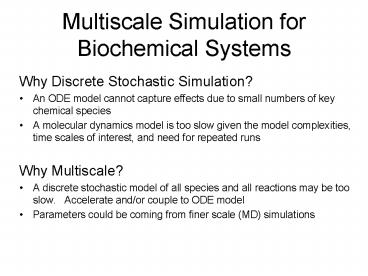Why Discrete Stochastic Simulation PowerPoint PPT Presentation
Title: Why Discrete Stochastic Simulation
1
Multiscale Simulation for Biochemical Systems
- Why Discrete Stochastic Simulation?
- An ODE model cannot capture effects due to small
numbers of key chemical species - A molecular dynamics model is too slow given the
model complexities, time scales of interest, and
need for repeated runs - Why Multiscale?
- A discrete stochastic model of all species and
all reactions may be too slow. Accelerate
and/or couple to ODE model - Parameters could be coming from finer scale (MD)
simulations
2
Software What do we have?
- Discrete stochastic simulation of well-mixed
systems MCell, StochKit, Cain/SSALIB, JigCell,
CellDesigner, CellMC, STOCKS, StochSim, SynBioSS,
TinkerCell, Moleculizer, - Some limited multiscale capabilities
3
Software What do we need?
- Stiff stochastic systems
- Adaptive multiscale
- Probabilities of rare events
- Sensitivity analysis, uncertainty quantification,
reduced order stochastic models - Parameter estimation
- High performance, for example GPU
4
Spatial stochastic simulation
- Huge problem of computational complexity
- Large numbers of diffusive transfers must be
aggregated to enable parallelism - Intrinsic physical limitations put lower bound on
spatial grid size - Mathematical and software infrastructure must
support complicated geometries, unstructured
meshes - Molecular crowding effects reaction propensities,
but by how much?
Unfolded protein response in the endoplasmic
reticulum C. Young, A. Robinson, U. Delaware
Polarization in yeast mating T. M. Yi, UC Irvine
5
We need a collection of community models!
- Why?
- Facilitate development and extension of models
- Experiment with published models and
validate/invalidate with new experimental data - Demonstrate the issues that computational
infrastructure need to address - Test the viability and efficiency of new
algorithms and software on realistic models - Issues
- Requires a common modeling language and/or
standards and expectations for publication - The language must be extensible to accommodate
unforseen future needs
PowerShow.com is a leading presentation sharing website. It has millions of presentations already uploaded and available with 1,000s more being uploaded by its users every day. Whatever your area of interest, here you’ll be able to find and view presentations you’ll love and possibly download. And, best of all, it is completely free and easy to use.
You might even have a presentation you’d like to share with others. If so, just upload it to PowerShow.com. We’ll convert it to an HTML5 slideshow that includes all the media types you’ve already added: audio, video, music, pictures, animations and transition effects. Then you can share it with your target audience as well as PowerShow.com’s millions of monthly visitors. And, again, it’s all free.
About the Developers
PowerShow.com is brought to you by CrystalGraphics, the award-winning developer and market-leading publisher of rich-media enhancement products for presentations. Our product offerings include millions of PowerPoint templates, diagrams, animated 3D characters and more.

